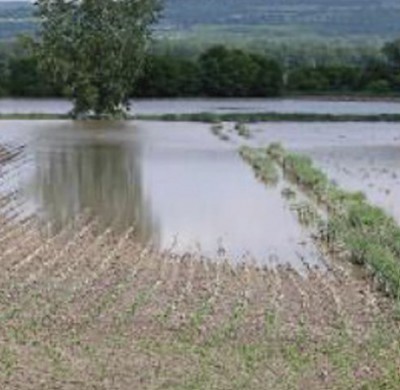Assessing Forage Crop Damage from Recent Weather Events

By Joe Lawrence; PRO-DAIRY
Reports of isolated crop damage due to recent weather events range from flooding to hail to wind. While some of these events have impacted relatively small areas in NY, the damage is greater in other areas of the Northeast. Regardless of whether a few acres or several fields were affected, it is helpful to get out and scout your crops to understand the impacts.
For corn, the stage of growth is important to the potential level of impact. Fortunately, the recent damage was predominately in pre-tassel corn, which generally results in a lower negative impact compared to damage occurring later in the season. For hay crops the timing between cuttings should be considered when assessing damage. Remember to consult with USDA and crop insurance representatives to document damage before taking any actions in the field.
FLOODING
Key points related to flood damage of forage and row crops are explained in Managing Flood Damaged Crops from Penn State University. Key points across crops include:
• Height of water (silt line)
• Length of time the crop is underwater
• Contamination impacting quality and feed hygiene (ash, molds, and toxins)
• Silt resulting in extra wear on harvest equipment
• Debris in field which could harm equipment or end up in forage
HAIL
Defoliation from hail typically looks worse than it is. The loss of leaves in pre-tassel corn will have relatively small impacts on yield and quality due to the loss of leaf material. However, providing good growing conditions for the remainder of the season, the plant will progress to pollination and ear fill with relatively little impact.
The same applies to hay crops, with slight impacts on yield and quality due to leaf loss. The exception is extreme damage with significant defoliation. In this case, the plants will need to be cut to encourage regrowth. The decision to harvest the crop or just chop the material back onto the field will be a case-by-case decision based on:
• level of damage
• expected forage quality (keep in mind most of the nutritional value of a crop like alfalfa is in the leaf)
• need for forage
• ability to store this lower quality feed in a separate storage based on quality and animal groups
WIND DAMAGE
There have been isolated reports of corn knocked over by wind shears. Given the average stage of corn at this point in the season, the critical point is to assess whether stalks are broken or just bent over. Some recently observed fields had relatively wet soil conditions which resulted in some corn tipping over due to partial uprooting versus stalk snapping. While this partial uprooting will have a negative effect on the crop, it likely will not die. Impacts to prepare for can include:
• compromised growth due to a smaller root system
• "goose-necking" in the regrowth which can impact harvest flow
• potential for less stability (reduced standability) of the crop later in the season
If the stalks are snapped, then the plant is likely dead.
EMERGENCY FORAGES
When damage occurs, a common reaction is to think about emergency crops to replace the damaged crop. First, do not overreact. Take time to truly assess the damage and viability of the crop. Often the resilience of the crop will surprise you. Further, even if the current crop's potential is compromised, the remaining potential (yield and nutritional fit for animals) may still be greater than that of a late planted "emergency forage".
Other considerations include:
• viable options for emergency forage crops at this point in season (see Agronomy Fact Sheet # 114: Emergency and alternative summer annual forages)
• herbicide rotation restrictions
• nutritional profile of current crop compared to new crop in meeting herd needs (i.e. forage oats have a different nutritional profile and role in diet than corn silage)
• current forage inventories
• availability of other crops (corn for grain that could be harvested as silage)
Upcoming Events
Crops, Cows & Critters - Southwest New York Dairy, Livestock & Field Crops Newsletter Sponsorship
December 19, 2025
Our two forms of publications feature research-based and timely information from our four specialists, listed to the right, along with local event notifications and Cornell University outreach. This information is provided to participants who range from dairy, livestock, and field crops producers to agricultural suppliers and consultants.
Weekly Email Update: Shared with 625+ households who have signed up with our program.
Monthly Paper Mailer: To reach our stakeholders and farmers who lack internet access, we send out a monthly mailer where your company's logo and contact information would be featured with a mailing list of 330+ households.
If you sponsor our weekly and monthly publications you reach approximately 955 households.
Visit our website to view our newsletters!
2025 Cornell Food Beverage & Animal Feed Manufacturer Survey
December 19, 2025
Industry and Educational Advocates for New York State's Food, Beverage, and Animal Feed Manufacturing industries:
As you know, NYS has a diverse food and beverage manufacturing industry, in both the types of industries that exist and the wide distribution of firms by scale. Many manufacturing firms have strong backward linkages to agricultural production sectors in the state that support both farm-level and downstream food industry firms and consumers. In collaboration with the New York State Department of Agriculture and Markets, a team from Cornell University's Charles H. Dyson School of Applied Economics and Management has recently rolled out the 2025 New York State Food, Beverage, and Animal Feed Manufacturer Survey. The industry will benefit from an updated assessment of the industry that informs private and public investments and opportunities to support firm growth and improved profitability.
Boots in the Barn: Cornell Dairy Research Updates
January 13, 2026
January 20, 2026
January 27, 2026
February 3, 2026
February 10, 2026
February 17, 2026
February 24, 2026
Join us for some or all!
Announcements
No announcements at this time.





